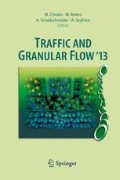Abstract
Pedestrians move freely in an open space by stepping forward. When the navigational situation becomes difficult, say in a dense crowd, they adjust their stride length and speed. The Optimal Steps Model uses local optimization on a circle around a pedestrian to determine the next position. The target function is a navigational field. Each individual’s stride length, that is, the circle radius depends on his or her speed. This introduces a delay in adaptation, because all speed measurements involve the past. A real person, however, is more likely to react instantaneously. We model this effectively by optimizing on a disk instead of a circle. The radius is chosen in accordance with the pedestrian’s free-flow velocity. A two dimensional continuous optimization problem ensues that we solve efficiently thus maintaining fast computational speed. Our simulations closely match real walking behavior which we demonstrate for navigation around a column in a narrow corridor and behavior at a bottleneck.
Access this chapter
Tax calculation will be finalised at checkout
Purchases are for personal use only
References
M. Chraibi, A. Seyfried, A. Schadschneider, Generalized centrifugal-force model for pedestrian dynamics. Phys. Rev. E 82(4), 046111 (2010)
D. Hartmann, Adaptive pedestrian dynamics based on geodesics. New J. Phys. 12, 043032 (2010)
D.M. Himmelblau, Applied Nonlinear Programming (McGraw-Hill, New York, 1972)
G. Köster, D. Hartmann, W. Klein, Microscopic pedestrian simulations: from passenger exchange times to regional evacuation, in Operations Research Proceedings 2010: Selected Papers of the Annual International Conference of the German Operations Research Society, ed. by B. Hu, K. Morasch, S. Pickl, M. Siegle (Springer, Berlin/Heidelberg/New York, 2011), pp. 571–576
G. Köster, M. Seitz, F. Treml, D. Hartmann, W. Klein, On modelling the influence of group formations in a crowd. Contemp. Soc. Sci. 6(3), 397–414 (2011)
G. Köster, F. Treml, M. Gödel, Avoiding numerical pitfalls in social force models. Phys. Rev. E 87(6), 063305 (2013)
J. Liddle, A. Seyfried, B. Steffen, W. Klingsch, T. Rupprecht, A. Winkens, M. Boltes, Microscopic insights into pedestrian motion through a bottleneck, resolving spatial and temporal variations (2011). arXiv, 1105.1532v1
M. Moussaïd, D. Helbing, G. Theraulaz, How simple rules determine pedestrian behavior and crowd disasters. Proc. Nat. Acad. Sci. 108(17), 6884–6888 (2011)
J.A. Nelder, R. Mead, A simplex method for function minimization. Comput. J. 7, 308–313 (1965)
M.J. Seitz, G. Köster, Natural discretization of pedestrian movement in continuous space. Phys. Rev. E 86, 046108 (2012)
J.A. Sethian, A fast marching level set method for monotonically advancing fronts. Proc. Nat. Acad. Sci. 93(4), 1591–1595 (1996)
J.A. Sethian, Level Set Methods and Fast Marching Methods: Evolving Interfaces in Computational Geometry, Fluid Mechanics, Computer Vision, and Materials Science (Cambridge University Press, Cambridge/New York, 1999)
A. Treuille, S. Cooper, Z. Popović, Continuum crowds. ACM Trans. Graph. (SIGGRAPH 2006) 25(3), 1160–1168 (2006)
I. von Sivers, Numerische Methoden zur Optimierung der Schrittrichtung und -weite in einem Modell der Personenstromsimulation. Master’s thesis, Fernuniversität in Hagen, 2013
Acknowledgements
This work was funded by the German Federal Ministry of Education and Research through the project MEPKA on mathematical characteristics of pedestrian stream models (grant number 17PNT028).
Author information
Authors and Affiliations
Corresponding author
Editor information
Editors and Affiliations
Rights and permissions
Copyright information
© 2015 Springer International Publishing Switzerland
About this paper
Cite this paper
von Sivers, I., Köster, G. (2015). Realistic Stride Length Adaptation in the Optimal Steps Model. In: Chraibi, M., Boltes, M., Schadschneider, A., Seyfried, A. (eds) Traffic and Granular Flow '13. Springer, Cham. https://doi.org/10.1007/978-3-319-10629-8_20
Download citation
DOI: https://doi.org/10.1007/978-3-319-10629-8_20
Published:
Publisher Name: Springer, Cham
Print ISBN: 978-3-319-10628-1
Online ISBN: 978-3-319-10629-8
eBook Packages: Mathematics and StatisticsMathematics and Statistics (R0)

